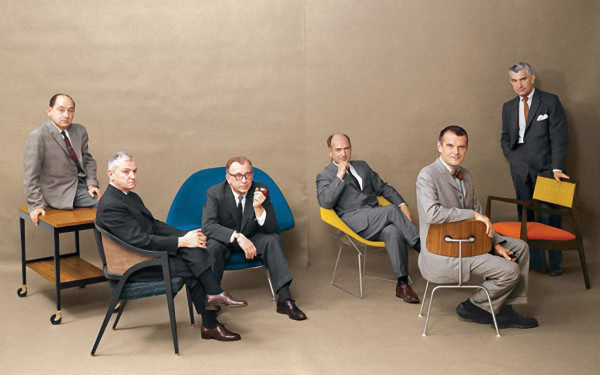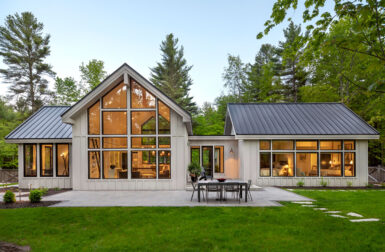It was at last month’s 2015 Consumer Electronics Show where technology giant Samsung unveiled a surprise collaboration with prolific designer, Yves Béhar. No stranger to technology, Béhar’s design firm Fuseproject has worked on an array of electronic devices ranging from home automation, personal audio, and even robotic cleaning appliances. It was this portfolio reflecting the designer’s commitment to the democratization of technology which attracted the Korean electronics giant to seek and collaborate on a flagship project.
Taking into account Béhar’s previous designs, this latest project is notably different. Reminiscent of a Richard Serra sculpture, the expansive Samsung S9W’s curved 82-inch display sits atop of a gradient adorned metallic cube, an elementary building block disguising the wealth of video and audio technology driving Samsung’s flagship 4K resolution UHD television. The nano-crystal semiconductor filtered, quantum dot Samsung S9W display is a monolith of technological futurism to behold, whether on or off. Where other Béhar designs are often bright, textured, and playful, the pedestal display S9W exudes a sparse, reductive sophistication somewhat evocative of Bang & Olufsen’s best “electronics as showpiece” philosophy or Apple’s dedication to intuitive simplicity – an artful celebration of the television transitioning beyond mere utility appliance and toward the category of an objet d’art worthy of display.
We sat with Béhar and his collaborator on the project, Yun-je Kang, Samsung’s Senior Vice President of the Visual Display Design Group, in a meeting room above the show’s inescapable din (alongside an entourage of Samsung representatives carefully recording everything asked and said) to discuss the designer duo’s motivations, inspirations, and challenges they faced while attempting to redefine the relationship between viewer, television, and the home.
Yves Béhar: Mr. Kang and I have known each other for quite a long time and we’ve worked very closely together… this closely together [motioning their distance only a few feet apart] for five or six years. And it’s really a designer-to-designer relationship, as well as with a Samsung design team which he leads. But in the last few years, we’ve conceptualized a lot of new types of products and new types of experiences. Not just looking at sort of the marketplace of TVs – like what size and what technology is there – but really integrating these new technologies with user behavior alongside design inspiration in hopes of defining new spaces for televisions.
The Samsung S9W television is the first one that we share together with the world, in a sense. And it’s a very different sort of perspective on a TV. In a sense, it’s a new expectation of a TV that has less friction, less connectors… less. Everything is integrated in the cube. All the complexity is put in a cube. And it’s one that’s also a lot closer to a world where people want their electronics to be part of their furniture, part of their home environment. And so, those were two of the key criteria of the collaboration.
Yun-je Kang: If we go back and take a look at how the design for the S9 began, what’s interesting about Samsung is that the management visited the furniture exhibition in Milan. I’ve been going since 2000. I’ve met Yves there. And so I think that this kind of a phenomenon within our company plays an important role in the design of our products. We are really evolving these electronics products into lifestyle products.
You mention “lifestyle products”. From the perspective of a designer working with home electronics, how far along do you believe you’ve integrated electronics – specifically televisions – into the living space?
Yves Béhar: I think electronics traditionally have been really kind of their own category, complex products with a lot of friction that traditionally have not considered all that has to happen in a home installation, including all of the connectivity and whatnot. When you come to a show like CES, everything looks perfect: everything looks mounted perfectly on the walls, everything is behind the walls and whatnot. But I think as designers who are passionate about the home environment where the product ends, we see this as maybe midway through the evolution of how electronics are going become a lot more integrated into the home. And the experience is a lot more seamless with your environment, with your life.
Are there any furniture equivalents which share the same design DNA with the S9W?
Yves Béhar: Mr. Kang and I are both very passionate about Herman Miller! He loves Herman Miller, I obviously love Herman Miller.
But it’s not about looking at furniture and doing something derivative. It’s more like looking at a chair and thinking that a chair could be something very different. And innovating around that standard or format. That’s the way Herman Miller has created classics.
So what was the pivoting point away from mere imitation, redirecting the design of the S9W toward innovation?
Yves Béhar: We started with very conceptual sketches and my impressions of the technology. I first saw a curved TV about 18 months ago; they sent me a prototype. And honestly before seeing it, I thought, “Well, okay. There was a TV that’s flat, and now there’s a TV that’s curved. What’s really the difference? Why is it that special?” And then when I got one, and I sat in front of it and I felt a lot more immersed because of the curve.
When you look at the history of art and displaying things on, around us, paintings and pictures around us, it’s always flat, right? It always fits flat. But something new and different happens when you sit in front of a curved display. Suddenly, it becomes a sculpture. It also surrounds the viewer. When it’s not flat, it becomes more like a sculpture and less like a painting.
So why place this sculpture on a wall? Or why place it on an easel, like it has been traditionally done. If it becomes a sculpture, it has to be displayed as such…a balancing act where the display is placed on top of all the components of television technology.
This seems divergent from the consumer trend to attempt to hide or blend in large televisions into the home. You seem to want to almost celebrate having a television. It’s something that you’re not attempting to hide…
Yves Béhar: Right. Yeah. I mean, I don’t think hiding is what people want. That said, they don’t want addition, you know?
Design sometimes is perceived as additive, adding decoration. But it also has to have a gesture. The things you want to bring into your lives are only worth it if there is something that you can identify with a strong idea or emotion. And in a way, that’s what we believe we’ve created: a new idea of what the TV can be in your living environment.
Yun-je Kang: Long ago I began asking, “Who makes these TVs? Who designs these TVs?” I’ve been designing TVs for about 20 years, since the era of CRT televisions. If you look back 20 years ago, most of the TVs were very black. They were very masculine, and it wasn’t really something you wanted to show off in the living space. But if you look back further, decades further, televisions were actually more beautiful at the time, and more like a furniture.
And 20 years ago when I would attend the Milan furniture fair I’d see radios by designers, but never televisions in the exhibition. So I began wondering why TVs were missing from this lifestyle space and from the home environment of consumers. And I think that was really the starting point for our team to really dive into “designing” TVs. That was about 10 years ago, and we knew that TVs were going to get bigger, and consumers would soon not want to hide them. We knew that televisions needed to be integrated into the living space.
There are some consumers out there who still feel that a TV is just simply an electronic device, and I think it’s our job, as designers, to lead the trends beyond that perception. – Yun-Je Kang
I think that Yves’ sculpture design for the S9W is an interpretation and answer to those same questions: “Who makes these TVs? Who designs these TVs?”
We’ve been collaborating on this product for about a year and a half, but Yves and I have been thinking about those questions even before the project began. We would talk about the living spaces of today, how we’d design a living space, and what an ideal television for that space would be. And so that process began a lot earlier than the 18 months we worked on the S9W.
As an electronics company Samsung has many engineers and marketing people, but it’s very difficult for them to make these observations about design. We have a role to push the engineers and marketers to really gain this perspective that nobody was questioning. I think back 20 years ago and I thought about who is designing these TVs? They were mostly males. Nobody really endeavored for a TV to be elegant, or designed them to integrate into the living space. Everybody focused on the functionality of the display, and that’s why we saw so many black and matte TVs [in the CRT era]. I think that at the end of the day, Yves’ sculpture design can also open a new trend for TV designs.
Rewinding to the 1950s and ’60s, the golden era of television industrial design: Designers back then had to work around the size issue, encasing cathode ray tubes in cabinetry and beautiful woodwork. Do you feel like this is the beginning of a renaissance? Where the size again is driving design toward artful objects? Because I’ve lived with a curved television, and it was tougher…
Yves Béhar: I think the world we live in today is not about technology being separate from the rest of our lives. User behavior, user desire… this pent-up demand for the things around us to be a part of everything has to be holistic. Many of us care and consider about every aspect of our homes now. We care for the door handles, we care for the sink, and shower heads.
Previously electronics used to be designed to follow certain specs. Making sure that the aspect ratio, memory size, etcetera. But design is a perfect ally for a transition between technology, user needs, and design inspiration and the integration of these products in your living room.
So, yes, it’s more like a sculpture today. In fact, the first time I saw the curved TV, I thought about Richard Serra’s sculptures. They have a presence. It’s quite different, they acquire their own personality. We can’t just say the TV needs to disappear. It has a presence now. And if it has a presence, it deserves a design to reflect that.
What about the technological elements which have traditionally cluttered the home? How do you see the S9W fitting into the average home?
Yves Béhar: In regards to people wanting less clutter, people wanting specific materials or shapes…it’s all certainly part of the drive behind our design solution. That’s why the cube is extremely simple. We needed openings for the sound to travel and so we made the cube open up for audio performance. But the rest of the time, it’s a very clean, restrained and discreet presence. It’s sculptural, yes, but it’s also an integrated and discreet part of the home.
Yun-je Kang: I have to note that the S9W is our premium model; it’s a high-end model so I guess the users would have to employ some creativity if they were to integrate that into a very normal kind of family living room.
For instance, the aspect ratio for the TV isn’t your normal 16:9, it’s 21:9. It’s very wide and so this itself, this feature itself, I think, is a bit different from your normal TVs. And so we couldn’t apply an “in the box” design idea. The S9W is very pragmatic, and at the same time, it’s timeless. A sculpture is timeless.
This is the first time designers are actually at the forefront. We’re actually making decisions, and are actually tempering the kind of the feature creep which sometimes creates an overbearing technological presence in our lives. – Yves Béhar
There are some consumers out there who still feel that a TV is just simply an electronic device, and I think it’s our job, as designers, to lead the trends beyond that perception. We can’t do that solely by focusing on the models that simply sell well, and to be a leader in the design space, I think we constantly have to push the envelope with new designs. And so if you look at the S9W it has no clutter whatsoever. You don’t need all the surrounding devices like the speaker. It’s all integrated into the metal cube base. I see it as creating space because you don’t need anything else.
In fact, the back is so cleanly designed, you don’t even have to place it near a wall to hide that angle of view. It can be in the center of the room and yet it would be completely clean. And I think that that’s kind of like the design achievement.
Yves Béhar: The 21:9 format is also a reflection of a developing consumer trend. A lot of us tend to watch a lot less or very little live TV. We’re watching a lot of things on our smaller devices. Yet, there’s also a place for an immersive cinema scale, in the right format. And so this particular TV – a very high-end display with great sound – is really built around the need for those times when we’re looking for an immersive cinematic experience.
You’ve been witness to so much change in the transition from CRT to flat screens…a major revolution. Is there a similar technological innovation which may open another chapter of evolution/revolution as designers?
Yun-je Kang: I believe anything is possible, really. We might be able to one day have TVs embedded into mirrors or TVs that become transparent when turned off!
But I want to say that technology isn’t everything because the real value created for customers from a design perspective is as TVs become thinner, owners will be able to save space, and in turn they’ll be able to do more with that space. I really want to emphasize we’re not trying to focus on a specific technology. You need to be able to convince users any new technology is relevant and convenient for adoption, and I think design will play a very important role in realizing these goals.
After 20 years of designing televisions you’d might think that there may not be much to look forward to, but if I think about how technology and design are coming together, I really am looking forward to the future and collaborating with Yves further.
Yves Béhar: I think design is the best ally to technology, and I don’t think that’s always been obvious to consumers. But when it comes to removing friction…when it comes to bringing new, creating new categories or reinventing existing categories… it’s really gonna be the marriage between new emerging technologies, pent-up user needs yet addressed, and design coming together. I think you’re gonna see a lot more exciting form factors changing user interaction and expectations with technology, like through IOTs [Internet of Things]. The TV has to play a part in that evolution of technology around us to make the world of objects a lot more autonomous. You see all the autonomous car stories, and in many ways, we think of everything around it as around us as being connected now and having to respond intelligently to users, and that evolution will include the TV.
Is there anything that you’ve seen out at this year’s Consumer Electronics Show – outside of the Samsung hall – that you’re very excited about?
Yun-je Kang: I think UX is going to become more and more important from a design perspective, integrating the exterior of the design, the product design with the UX or UI. For instance, with projectors you can integrate graphics onto any surface and provide new value for the consumer. I also believe the Internet of Things will lead to more design opportunities, alongside allow us as designers to observe how these technologies are integrated into people’s lives.
Yves Béhar: Home automation. Just a few years back, any kind of home automation was an extremely expensive proposition, and today people are buying very affordable devices. The price point is going to continue getting lower and the experience is going become more magical. Sensors and connectivity is starting to really allow designers to really think about the future of the home, the future of security, the future of entertainment, and the future of that integration.
When you think about bringing technology into the home, it can’t just please the techie in the home… it can’t just please the person who installed it. Everybody has to love it. And by “everybody” I mean a huge range: it could be grandparents, it could be children, it could be the people in-between. And so I think this trend of automation very much democratizes the idea of technology within home environments. And I think that democratization is only going to accelerate, and it’s a huge opportunity for us because now – compared to any other big technology cycle– this is the first time designers are actually at the forefront. We’re actually making decisions, and are actually tempering the kind of the feature creep which sometimes creates an overbearing technological presence in our lives. Designers have more to contribute, have more power, and we are going to really drive a lot of what is going to be happening in the future.
*Special thanks to Yves Béhar, Yun-je Kang, and the Samsung team.






























